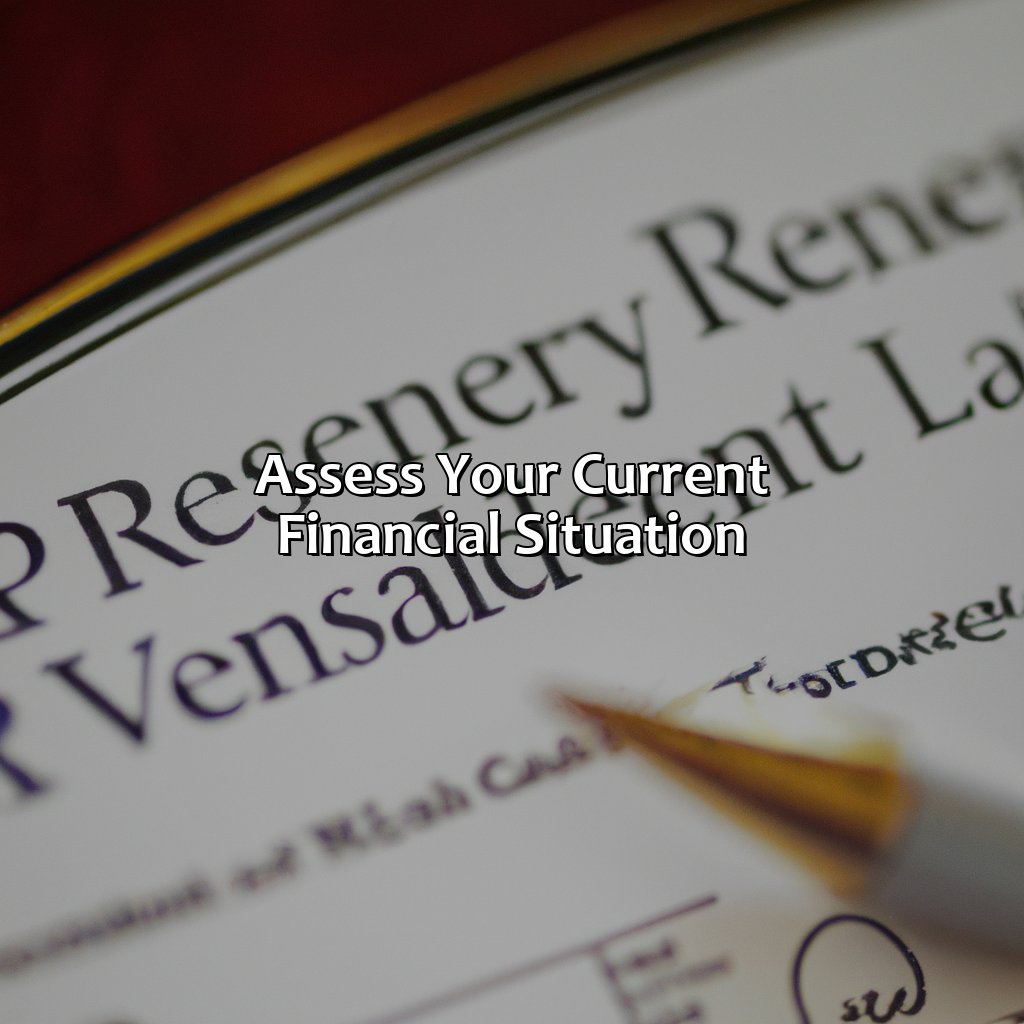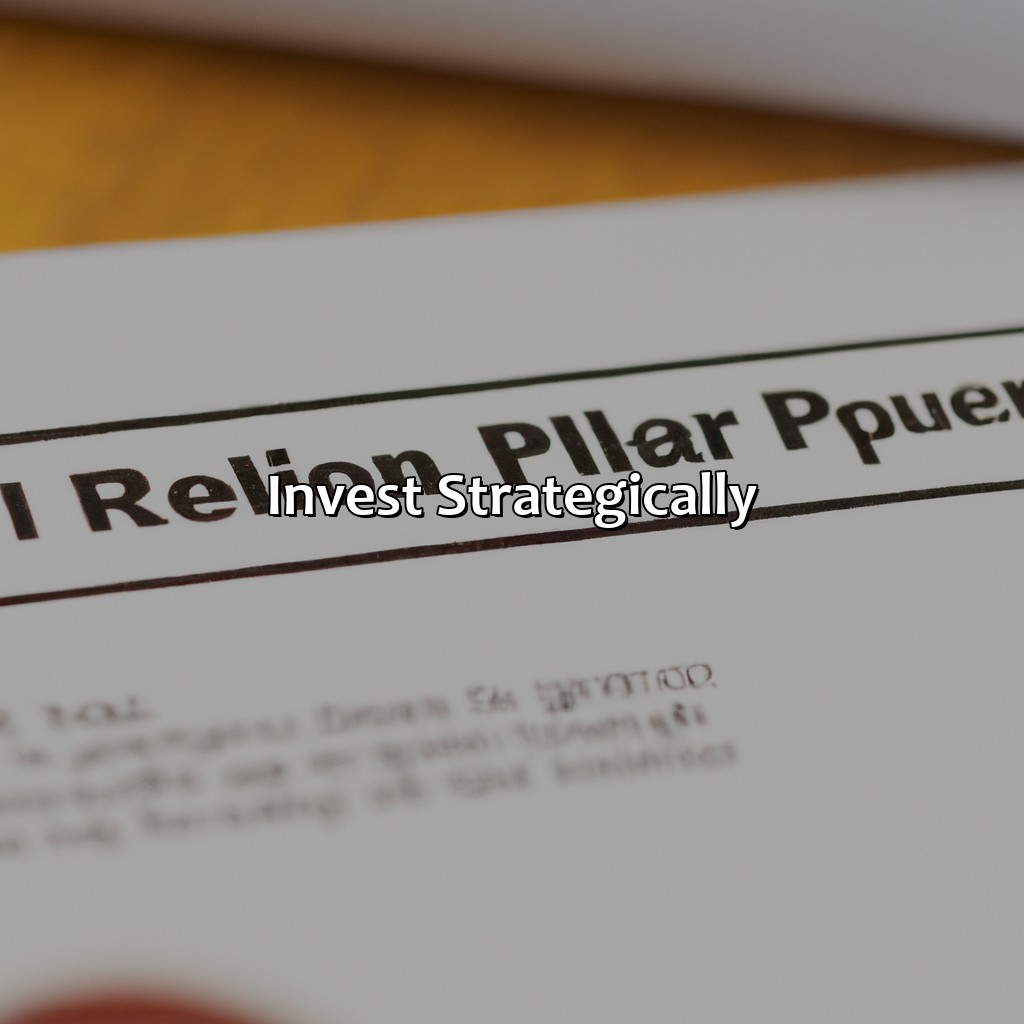How To Win At Retirement Savings?
Key Takeaway:
- Assess your current financial situation: Before creating a retirement savings plan, you need to understand your current financial situation. Calculate your net worth, income, expenses, and debts to determine how much you can realistically save for retirement.
- Determine your retirement goals: To create a realistic retirement savings plan, you need to determine your retirement goals, such as when you want to retire and how much income you will need to live comfortably. Use retirement calculators and speak with financial professionals to help determine these goals.
- Invest strategically: Investing strategically in a diversified portfolio and monitoring and adjusting investments regularly can help maximize retirement savings. Consider low-cost investment options and tax-advantaged accounts to minimize fees and taxes.
Are you worried about how much you should save for your retirement? You can take control of your finances and reach your retirement goals with these simple, practical steps. Learn how to win at retirement savings today.
Assess Your Current Financial Situation
Assessing Your Financial Status for Retirement Savings
To prepare for retirement, understanding your current financial status is of utmost importance. Begin by reviewing your income sources, such as your job, pension, and investments. Determine your expenses and assess your debt. Look into your current savings and investments, including retirement accounts. Analyze your insurance policies, taxes, and estate plans to see how they align with your retirement goals.
During this process, identify areas in which you can reduce your expenses and increase your savings. Look for opportunities to contribute more to your retirement accounts, and consider investing in a diverse portfolio that aligns with your risk tolerance.
Finally, seek out professional financial advice to help optimize your retirement savings plan. A financial advisor can help you identify areas of improvement, address any concerns, and develop a personal retirement strategy to help you meet your goals.
Taking the time to assess your financial status and make any necessary changes can not only help you reach your retirement goals but also provide peace of mind for a comfortable retirement. Don’t wait until it’s too late – start now and secure a financially stable future.

Image credits: retiregenz.com by James Jones
Determine Your Retirement Goals
Determining Your Retirement Objectives
Securing your financial future starts with determining your retirement objectives. Establishing what you want your post-retirement life to look like will help you identify how much money you will need for that phase of your life. Think about factors like your desired lifestyle, health concerns, and any other goals you may have in mind. Once you’ve determined this, you can start planning for how to achieve those objectives.
It’s crucial to create a realistic budget for your retirement years that covers all your expenses, from housing to healthcare to leisure activities. The earlier you start saving, the easier it will be to achieve your goals. You may also consider seeking professional advice in the planning process to make informed decisions for a smooth and blissful retirement.
A sound retirement plan requires careful consideration and regular adjustments based on changes in your life. Developing a clear understanding of your objectives is the backbone of an effective retirement strategy.
According to a recent survey by the Transamerica Center for Retirement Studies, 55% of workers have less than $50,000 saved for retirement, highlighting the importance of early planning.

Image credits: retiregenz.com by Joel Jones
Create a Retirement Savings Plan
For building a retirement savings plan, there are 3 solutions:
- First, decide on the right retirement savings accounts for you.
- Second, decide how much to save monthly.
- Third, maximize your employer plan contributions.
All these steps are key to customizing your retirement plan and satisfying your individual needs.

Image credits: retiregenz.com by Harry Woodhock
Decide on the Best Retirement Savings Accounts for You
When mapping out your retirement savings, it’s crucial to choose the most suitable account based on your objectives and circumstances. Consider the statement “Optimize Your Retirement Savings With Selecting the Right Account“.
- Understand each account’s advantages.
- Compare tax rates and implications for each retirement account.
- Review transaction fees before opening any new accounts.
- Evaluate the accessibility of funds after you retire.
In addition, determine if there are limitations such as age restrictions or eligibility requirements that may apply to specific accounts.
Pro Tip: Consult with a financial planner to identify which retirement saving approaches would best suit your lifestyle.
Saving for retirement is like playing a game of Jenga, but instead of removing blocks, you add money each month until your tower of savings doesn’t come crashing down.
Determine How Much You Need to Save Each Month
Knowing the appropriate amount to set aside monthly is key to achieving your retirement goals. Determine a suitable monthly savings amount by evaluating current expenses, income and future requirements. Consider tax implications, inflation, investment returns and other relevant factors. Regularly review and adjust your savings plan as necessary for maximum benefit.
To find your ideal monthly pension contribution rate, take advantage of online calculators or consult a financial advisor. Strive for an amount that allows you to retire without relying solely on social security benefits or employer pensions. Maintain consistent contributions by automating transfers and investing in diversified funds rather than single stocks.
Keep in mind that unforeseen circumstances may alter your retirement plans. Saving more than the recommended amount can provide a safety net while growing your wealth over time before your golden years arrive.
A recent survey conducted by TIAA found that nearly half of all Americans have less than $10,000 saved for retirement, highlighting the importance of creating and sticking to a personalized savings strategy. Don’t wait until it’s too late – start prioritizing your financial future today with proper planning and disciplined actions.
Your employer’s retirement plan contributions may not make you rich, but at least they’ll make you feel like someone else cares about your future.
Maximize Your Employer’s Retirement Plan Contributions
When it comes to building a robust retirement savings strategy, increasing your employer’s retirement plan contributions can be immensely beneficial. Here are six ways to get the most out of your employer’s retirement plan contributions:
- Ensure you understand your employer’s retirement plan: This will help you make informed contribution decisions and take advantage of any matching contributions.
- Contribute enough to qualify for the full employer match: This is essentially free money that can significantly boost your savings over time.
- Make pre-tax contributions: This reduces your taxable income and can increase the amount you save by lowering taxes you pay now.
- Consider contributing to a Roth 401(k): This option allows you to make after-tax contributions and enjoy tax-free withdrawals in retirement.
- Don’t forget about catch-up contributions: If you’re over 50, you may be eligible to contribute additional funds each year.
- Review your investment options periodically: Ensure that they align with your long-term goals and risk tolerance level.
Apart from these points, it’s also important to note that there may be eligibility requirements or limits on how much an employer is willing or able to contribute. It’s therefore advisable to speak with a financial advisor or benefits representative for more personalized advice.
To maximize the potential benefits of your employer’s retirement plan contributions, it’s necessary to understand their specific terms and contribution tiers fully. Take the time needed to research and digest this information, as knowledge is power when it comes down planning for retirement.
Make sure not to miss out on opportunities for boosting your retirement savings by taking advantage of all possible levers available. In short, start strategizing today! Don’t put all your eggs in one basket, unless of course, that basket is a well-diversified investment portfolio.
Invest Strategically
Winning at retirement savings requires strategic investing with a diversified portfolio, plus regular monitoring and tweaking. This section explains the significance of diversifying investments, and how to monitor and adjust them. Sub-sections will give you the knowledge to make informed investment decisions, for maximum returns while minimizing risk.

Image credits: retiregenz.com by Yuval Duncun
Diversify Your Investment Portfolio
Investment diversification for optimal retirement savings
Expanding your investment portfolio with a diverse range of assets is essential in securing long-term returns. By including stocks, bonds, real estate and commodities such as precious metals, investors can mitigate risks and maximize profits. Varying asset classes within a portfolio reduces the impact of market volatility on an investment, minimizing losses while increasing gains.
Including international opportunities in your portfolio can further increase its diversity, as different markets offer unique characteristics. For instance, emerging markets often provide higher growth rates than established ones. Investing in exchange-traded funds (ETFs) and mutual funds can also widen exposure without requiring excess effort or knowledge.
Moreover, investing a portion of the portfolio in alternative assets such as private equity or hedge funds can generate non-correlated returns that may benefit the overall return profile. According to Investopedia, high-net-worth individuals allocate nearly 40% of their portfolios to alternatives.
Recent surveys by Deloitte have revealed that almost 60% of savers believe they cannot accumulate enough wealth for retirement due to volatile economic conditions and low interest rates on savings accounts. Implementing strategies like diversification into portfolios could improve investors’ income streams while providing a robust platform for retirement saving.
Remember, investing is like a relationship – you have to monitor and adjust regularly or it will end up in a costly divorce.
Monitor and Adjust Your Investments Regularly
Investment Optimization – a crucial aspect of your Retirement Savings plan:
Maintaining and Enhancing the potential of your investment portfolio is essential to meet your long-term financial objectives. Follow these five steps to optimize investments for retirement savings:
- Systematically Monitor Your Investments: Check your investments’ performance regularly, and change them proactively if required.
- Diversify Assets: Consider expanding risk management strategies by diversifying and investing in bonds, stocks or mutual funds.
- Rebalance Your Portfolio: Make sure your investment mix’s balance remains aligned with the goals you set earlier by periodically readjusting it.
- Consider Tax Efficiency: Reduce taxation on investments using suitable retirement accounts like 401(k)s or IRAs.
- Aim for Long-Term Growth: Invest for the long term with associated risks and rewards to reap maximum benefits from compounding over time.
To keep profits in check, don’t forget to conduct regular assessments beyond just portfolio returns. Take into account the inflation-adjusted actual return on investments. Keep an eye out for capital gains and dividend yield distributions as well.
Once Investment Optimization is achieved, consider automating the process entirely by selecting a Robo-Advisor. With this service, adjust portfolios to meet changing market conditions without getting bogged down in data analysis.
Optimal monitoring and adjustments have numerous advantages in sustaining efficient investment management while ensuring retirement readiness. In a nutshell, Investment Optimization can serve as a powerful means of facilitating financial stability post-retirement.
Some suggestions to guard against losing money through insufficient monitoring involve utilizing dollar-cost averaging strategies that maximize returns over extended timelines. Holding on to assets can offset losses when market downturns occur too; avoid acquisition bias once anxiety takes hold when prices drop below expected yields.
Money may not grow on trees, but it can certainly dwindle away with high fees and taxes – invest strategically and keep more of your hard-earned leaves.
Minimize Fees and Taxes
Lessen your retirement fees and taxes! Choose economical investment options. Think about accounts with tax benefits. These two choices can help you reduce fees and taxes for your retirement savings.

Image credits: retiregenz.com by James Duncun
Choose Low-Cost Investment Options
Low-Cost Investment Options can be a great way to minimize fees and taxes when saving for retirement. Here are five points to consider:
- Look for index funds or exchange-traded funds (ETFs) that have low expense ratios.
- Avoid mutual funds with high management fees, as they can eat away at your returns over time.
- Consider using a robo-advisor or online brokerage that offers low-cost investment options.
- When selecting individual stocks, look for companies with low price-to-earnings ratios and solid financial fundamentals.
- If you work with a financial advisor, make sure they prioritize low-cost options in their investment recommendations.
It’s worth noting that while choosing low-cost investment options is important, it shouldn’t be the only factor you consider when building your retirement savings plan. It’s also essential to diversify your portfolio across different asset classes and investment types.
One woman we spoke to saved diligently throughout her career but invested mainly in high-fee mutual funds. After retiring, she realized just how much these fees were costing her over time. She switched to low-cost index fund investments and was able to reduce her overall fees by more than 50%, boosting her retirement income significantly.
Tax-advantaged accounts are like superheroes, saving your retirement funds from the evil clutches of taxes.
Consider Tax-Advantaged Accounts
Utilizing tax-advantaged accounts play a vital role in minimizing fees and taxes when planning for retirement.
Using these accounts can help lower the taxable income and increase savings in the long-term. Here are six ways to consider tax-advantaged accounts:
- 401(k) plans
- Individual Retirement Accounts (IRAs)
- Roth IRAs
- Solo 401(k)s
- Health Savings Accounts (HSAs)
- 529 college savings plans
Apart from the ones mentioned earlier, there are several other unique options to choose from based on an individual’s financial goals and situation.
It’s crucial to remember that not taking full advantage of tax shelters can lead to missed opportunities for tax-optimization. So, explore all possible options before committing to one.
Finally, plan early and invest consistently while keeping an eye on your chosen account type’s contribution limits. This will ensure that you maximize savings towards your retirement goal.
Don’t miss out on ample opportunity to minimize fees and taxes when it comes to retirement planning; start strategizing today!
You can’t expect to retire like a king if you never bothered to learn how to save like one.
Continuously Educate Yourself on Retirement Savings
Incorporating Continuous Learning to Secure your Retirement Funds
To secure your retirement funds, it is crucial to continuously indulge in learning about retirement savings. Keep yourself updated with the latest trends in investments, financial policies, and interest rates. Maintaining a healthy understanding of these can help you prepare better for retirement.
Emerging tools and technologies can aid in tracking and managing your retirement planning, such as budgeting apps, financial blogs, and online calculators. Implement these tools in your retirement plan to ensure that you stay on track.
It is essential to distinguish between various models of investment schemes such as a Roth IRA, a traditional IRA or a 401(k). Knowledge about these can help you choose the best investment scheme that suits your future goal.
Mary, at the age of 35, had the knowledge of retirement savings and had invested in the right schemes. She was financially secure when she decided to take voluntary retirement from her corporate job. Education and awareness helped her justify her decision.
Keeping yourself updated with developments in retirement savings and investing in the right schemes can guarantee a secure future. It is never too late to start preparing for your retirement, and lifelong learning can help you achieve more significant financial freedom in your golden years.

Image credits: retiregenz.com by David Duncun
Seek Professional Advice When Needed
When seeking guidance for retirement savings, it’s wise to consult with a financial advisor. A professional advisor can analyze your financial status, provide advice on investments, and help you develop a plan that aligns with your goals. A trustworthy advisor can also provide peace of mind, ensuring that your retirement funds are in good hands. Remember, it’s never too early or too late to seek professional advice for your retirement savings.
To maximize your retirement savings, it’s crucial to have a comprehensive plan in place. Seeking advice from a professional advisor can help you establish financial goals, create a budget, and identify investment opportunities that align with your retirement plans. They can also guide you through tax-saving strategies, such as taking advantage of tax-deferred retirement accounts. Developing a long-term financial plan with an advisor will ensure that your retirement savings stay on track, no matter what life throws your way.
It’s essential to note that not all financial advisors are equal. Look for a professional who has the appropriate certifications and experience, and who is transparent about their fees and investment strategies. Make sure you feel comfortable with your advisor and trust their advice before committing to a plan.
According to a study by Vanguard, investors who work with financial advisors have a median annual return of 3% higher than those who do not use an advisor. Seeking professional guidance for your retirement savings could be the key to achieving your financial goals and securing your retirement future.

Image credits: retiregenz.com by Adam Woodhock
Five Facts About How To Win At Retirement Savings:
- ✅ Start saving as early as possible. The longer you wait, the more you’ll have to save to catch up. (Source: Forbes)
- ✅ Take advantage of employer-sponsored retirement plans, such as 401(k)s, and contribute enough to get the maximum employer match. (Source: CNBC)
- ✅ Diversify your portfolio to spread out risk and increase potential returns. (Source: NerdWallet)
- ✅ Consider consulting a financial advisor to help create a retirement plan and make informed investment decisions. (Source: Investopedia)
- ✅ Continuously monitor and adjust your retirement plan as your financial situation and goals change. (Source: The Balance)
FAQs about How To Win At Retirement Savings?
Q: How much should I save for retirement?
A: The amount you should save for retirement depends on several factors, such as your current income, desired retirement lifestyle, and expected retirement age. A general rule of thumb is to save 15% of your income, but it’s important to consult with a financial advisor to determine a personalized saving strategy.
Q: What types of retirement accounts should I consider?
A: There are several types of retirement accounts, including 401(k), individual retirement accounts (IRAs), Roth IRAs, and Simplified Employee Pension (SEP) plans. Each account has different contribution limits, tax implications, and investment options, so it’s important to research which accounts align with your financial goals.
Q: How can I increase my retirement savings?
A: One way to increase retirement savings is to take advantage of employer matching contributions offered in 401(k) plans. Additionally, contributing to a Health Savings Account (HSA) or investing in a diversified portfolio can also help increase retirement savings.
Q: How should I invest my retirement savings?
A: It’s important to diversify your retirement investments to minimize risk and maximize returns. This can be achieved through a mix of stocks, bonds, and mutual funds, as well as consulting with a financial advisor to determine an investment strategy that aligns with your goals.
Q: What role does debt play in retirement savings?
A: Debt can significantly impact retirement savings, as high-interest debt can eat into retirement funds. It’s important to prioritize paying off debt before increasing retirement contributions.
Q: At what age should I start saving for retirement?
A: It’s never too early to start saving for retirement, but the earlier you start, the more time your money has to grow. Ideally, individuals should begin saving for retirement in their 20s or 30s to ensure they have enough funds to support their desired retirement lifestyle.








